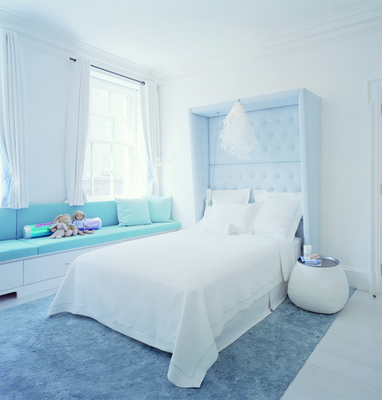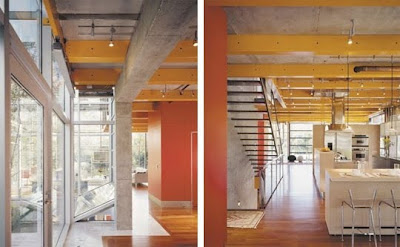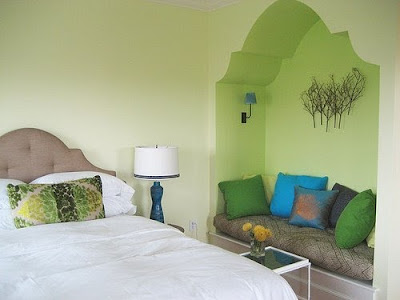It is rare we get a total free rein or start with a totally blank slate, the base color might be dictated by something you're stuck with such as a grey carpet or an avocado bathroom suite. However, this doesn't have to hold you back. Use the color wheel to look at what colors go with this color and decide whether to go for a tonal, harmonious, or complementary scheme.
Color schemes
For best results, choose one of the following schemes.
- Tonal - use just one color but varying tones of it throughout a room or use more than one color but all with the same depth of tone.
- Harmonious - pick colors next to each other or near each other on the wheel. These schemes generally give a look that's easy to live with and are tranquil and restful.
- Complementary - or 'contrasting' colors lie opposite each other on the color wheel. Complementary colors generally inject some life into a scheme, are more daring and will make more of an impact but might not be so easy to live with.
Create a mood
You may want to make your bathroom a relaxing, stress free spa with watery colors reminiscent of the sea. Or you may want to nudge your family to get going in the morning and inject some energy with splashes of zesty acid pastels. Take your inspiration from nature.
Play around with lighting to create moods for different situations, for example, romantic, practical, formal, entertaining etc.
Linking rooms with color
You may have loads of ideas for different color schemes in each room of your house and be dying to give them all a try. But stop and think of the overall effect when all the doors are open and you can see into each room. In a smaller house this can tend to look a bit of a mish-mash.
If you'd like to draw the whole scheme together, choose an overall color for the entire house and then use it in different ways in each room. Larger houses are slightly more forgiving as long as you pay attention to the meeting points.
If one room is wallpapered, try picking out one shade from it to paint the next room or use the background color of the wallpaper as your base color.
Don't forget the color on the opening side of the door into the next room - it doesn't have to match but pick a shade that won't jar.
Before you start
Once you've done your mood board and decided on your color(s) you are ready to go. But before you start painting:
- Buy some tester pots of your chosen color. Use the whole pot and paint quite a big stretch of wall (no smaller than four feet square).
- Don't paint lots of different striped colors in a rainbow. Paint onto pieces of non-absorbent white paper and stick onto the wall.
- Leave the sheets up for a few days, move them round the room and look at the paints in all lights.
- Remember if you want to keep up with fashion but don't want to have to start from scratch every time, keep the floor and large items of expenditure, such as the sofa, in a neutral color. That way you can simply change the color of the walls and accessories.
The colors used to decorate rooms in a house can affect the occupants' moods. Find out why:
Red
Associated with: danger, passion, energy, warmth, adventure, optimism
Best for: dining rooms as it promotes sociable and lively feelings, and stimulates the appetite
Pitfalls: it can be overpowering and lead to headaches. Either vary the shade, paint one wall red, or use it for accessories only. Don't use red in a baby's room







Pink
Associated with: love
Best for: bedrooms as it can be peaceful and restful. A hot fuchsia can introduce passion
Pitfalls: can be appear to be very girlie and sickly sweet. To counteract this, introduce hints of dark charcoal or black


Orange
Associated with: stability, reassurance, warmth, and is thought to aid digestion
Best for: living and dining rooms
Pitfalls: might keep the occupant awake when used in a bedroom. It can make a room look smaller because it's an advancing color, so make sure the room gets plenty of light







Green
Associated with: nature and energy, calming and restful, balance (halfway between red and blue) security, stability
Best for: bedrooms, living rooms
Pitfalls: too much green is thought to make people too complacent or too laid back. Inject some red or orange to counteract these feelings





Blue
Associated with: calming and soothing; promotes intellectual thought; believed to keep hunger at bay; loyalty, serenity, authority, protection, contemplative, prevents nightmares
Best for: bedrooms, bathrooms, studies
Pitfalls: can look cold and unwelcoming. Make sure it doesn't look too chilly by choosing a blue with a warm undertone





Yellow
Associated with: sunshine and energy, stimulates the intellect
Best for: kitchens, dining rooms or north-facing rooms
Pitfalls: not very restful for a bedroom. Yellow is thought to enhance feelings of emotional distress










Lilac
Associated with: spiritual matters - suggests the misty area between the sky and heaven, feminine
Best for: bedrooms and bathrooms to create a stress-free sanctuary
Pitfalls: can be insipid. Liven it up with black or silver, or both






Purple
Associated with: creativity, fertility, joy, but also magic, evil, death and sex
Best for: bedrooms
Pitfalls: can be overpowering


Brown
Associated with: security, stability and very practical
Best for: living rooms
Pitfalls: introduce a livelier color for mental stimulation such as green or blue





Black
Associated with: death, eccentricity, drama. It's a non-color that absorbs color and reflects nothing back
Best for: using in moderation
Pitfalls: depressing - think of all those angst-ridden teenage bedrooms. Use it to temper the sweetness of other sugary colors such as pink, but don't use it as a base color









There are plenty of tricks with color that can be used to enhance the size of rooms in a house. Careful use of color can offer a simple, but effective, way of making a home feel more cosy.
Follow these design rules to transform an existing living space into a dream home:
To make a room appear larger
- Choose colors from the cool end of the color wheel.
- Paint all surfaces the same color.
- Keep flooring dark and walls light , the floor space will appear to expand.
- A low ceiling will appear higher if painted a lighter shade than the walls or put some mouldings up and paint them a darker shade than the ceiling.
- Use the deepest tone of color near to the floor and the lightest shade on the ceiling. This will give the illusion of space. Try it the other way around to see how a room can be made to look smaller.
- Large pieces of furniture will appear smaller if they are the same color as the walls.
- A small room doesn't have to be painted in light colors. Emphasize its cosiness by painting it a midnight blue or deep red.
To make a room appear cosier
- Choose colors from the warm side of the color wheel.
- A sunny yellow will 'heat up' a room, but don't go overboard, complement it with a white ceiling and woodwork to keep it looking fresh.
- A warmer shade used on the ceiling will bring the height of a room down and make it feel cosier.
- When using bright colors such as orange and red, remember to maintain balance by keeping the floor and carpet neutral.
Other tricks
- The far end of a long corridor will seem closer if painted in a darker shade.
- In a long corridor-like room, paint the two, shorter end walls in a slightly darker shade to make the room appear squarer.
- The most important thing is to look at your chosen paint at all times of day. Pin up a sample and keep looking at it day and night and under electric light. Fluorescent strip lighting, in particular, will change its appearance.
- If the light in your country is cold and northern, it will make colors look dull. That stunning Mediterranean blue wall you saw on your travels probably won't work if you try to recreate it.
- Work out which direction your room faces. If it's north-facing then it's likely not to get much sun and it will probably feel cold. Shades from the cool side of the color wheel will make it look even colder, so warm it up with cosy tones.
- A south-facing room will get lots of light. If you want it to look sunny choose warm shades, although these might be overpowering in the full glare of the sun. To keep the room light and airy, choose cool shades.
- If your room is dark and dingy, painting it brilliant white won't help. White without light looks grey.
- Overhead lighting makes color look flat. Try using a dimmer and lots of ambient lighting.
- Paint turns darker when it dries. To check what you'll end up with before you put your paint on the walls, test it on non-absorbent white paper first, allowing it to dry thoroughly.
- A pale neutral may look washed out in strong daylight or artificial light - try a more intense shade.
- The finish of the paint makes a difference to the result. Gloss will look much lighter than matt eggshell. You'll also get a much lighter look if you're painting a smooth wall than if you're painting over textured wallpaper or using textured paint.
- Halogen bulbs give a truer representation of color than ordinary tungsten ones.
(Notes on color from BBC Home, Pictures are from AT, ElleDecor, Livingetc, CountryLiving, Architectural Digest, Domino, MarieClaire Maison, Martha Stewart, HousetoHome and Blogs)

























Sharon thanks for these tips about
ReplyDeletecolors for paint rooms.
I love most the orange and blue interior ^____^
WoW! You put a lot of time, effort and thought into this. Thanks so much for an exceptional post!
ReplyDeleteHave a nice weekend Sharon!
ReplyDelete@ Stella: thanks Stella, hope u had a great one too
ReplyDelete@ Pam Kersting: I had so much fun putting this together, glad u like it